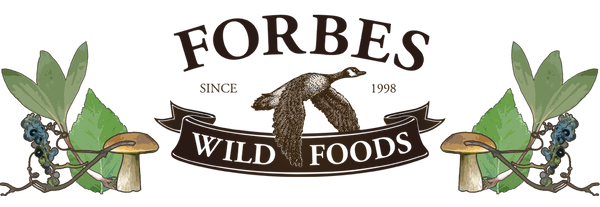Dried Nori
Nori Pieces
Nori is the commonly used Japanese name for red algae of the genus Pyropia. Like
many varieties of seaweed, Nori is a global coastal food, not limited to one ocean or
region. Forbes Nori is sustainably harvested and naturally dried in Nova Scotia. It
has not been pressed into Sushi Nori – the paper-thin sheets of puréed, dehydrated
algae that are used to wrap sushi and onigiri.
Making Sushi Nori is a fun D.I.Y. project that involves soaking then blanching Nori
Pieces, then puréeing and finely straining to create pulp. Spread the pulp thinly by
rolling between 2 sheets of parchment paper, and then dehydrate as if making fruit
leather. If you don’t have all day, make homemade furikake – an all-purpose
seasoning that bursts with umami flavour. Simply crumble nori along with toasted
sesame seeds, sea salt, and optional dried wild mushroom powder. Use on rice
bowls, soups or omelets.
In Wales, nori is called Bara lawr (translated as laver). Laver “bread” is actually a
purée of cooked seaweed, traditionally served as oatmeal coated fried patties, or
spread on bread toasted in bacon fat.
Like all sea vegetables, Nori differs nutritionally from plants growing on land. Sea
vegetables have a higher content of minerals such as calcium, potassium and iodine.
They are also rich in protein, amino acids, iron, vitamins and soluble and insoluble
fiber. Nori in particular is an especially good source of vitamin A.
Nori is the commonly used Japanese name for red algae of the genus Pyropia. Like
many varieties of seaweed, Nori is a global coastal food, not limited to one ocean or
region. Forbes Nori is sustainably harvested and naturally dried in Nova Scotia. It
has not been pressed into Sushi Nori – the paper-thin sheets of puréed, dehydrated
algae that are used to wrap sushi and onigiri.
Making Sushi Nori is a fun D.I.Y. project that involves soaking then blanching Nori
Pieces, then puréeing and finely straining to create pulp. Spread the pulp thinly by
rolling between 2 sheets of parchment paper, and then dehydrate as if making fruit
leather. If you don’t have all day, make homemade furikake – an all-purpose
seasoning that bursts with umami flavour. Simply crumble nori along with toasted
sesame seeds, sea salt, and optional dried wild mushroom powder. Use on rice
bowls, soups or omelets.
In Wales, nori is called Bara lawr (translated as laver). Laver “bread” is actually a
purée of cooked seaweed, traditionally served as oatmeal coated fried patties, or
spread on bread toasted in bacon fat.
Like all sea vegetables, Nori differs nutritionally from plants growing on land. Sea
vegetables have a higher content of minerals such as calcium, potassium and iodine.
They are also rich in protein, amino acids, iron, vitamins and soluble and insoluble
fiber. Nori in particular is an especially good source of vitamin A.
Back To All Products
Previous Product

